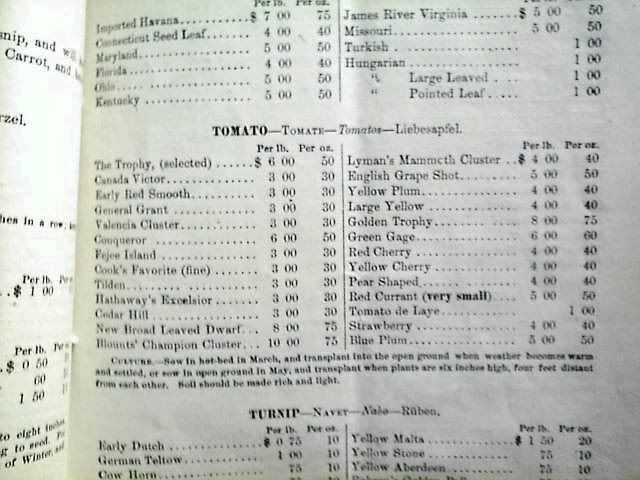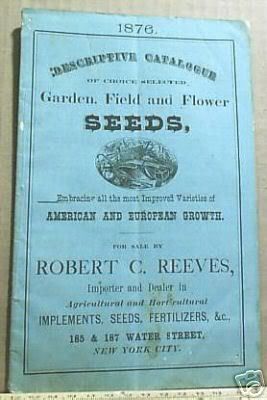

|
Historical background information for varieties handed down from bygone days.
|
 |
|
|
Thread Tools | Display Modes |
|
|
|
|
#1 |
|
Tomatoville® Moderator
Join Date: Jan 2006
Location: Hendersonville, NC zone 7
Posts: 10,385
|
With all of the activity around the Dwarf tomato breeding project, I thought it would be a good idea to look back and dig a bit on where this relatively rare form of tomato originated, and some info on the few varieties that exist - some of which we are using as breeding material.
From the April 1938 Michigan State Special Bulletin - Tomato Varieties, by Gordon Morrison, as well as information from a number of Michgan Ag Bulletins of large tomato trials in the late 1880s to early 1890s, we get the following: Dwarf Champion represents the group of intermediate or semi-dwarf tomatoes developed by means of crossing with other types the 18 inch dwarf form, Tomato de Laye, which originated in a garden at Chateau de Laye, France, in 1862. Vilmorin of Paris introduced, in about 1865, a variety called Tree Tomato that was very similar to Dwarf Champion. It lists it as being released in 1892, though it was included in the 1889 Ag College of Michigan trials - but not in the 1887 trials. I will have to look through my catalogs to see if I can figure out who released it, though it could be the Maule company. Fruits described as deep pink, flattened globe, 3 inches wide by 2.5 inches deep, 4 ounces. French Upright or Tomate de Laye (aka Tree Tomato) - not described in the Morrison, but it is in the Ag College of Michigan trials - interestingly, it states that it has irregular fruit nearly as large as Trophy, flattened, scarlet red, grown in pots in France. A chance seedling in the garden of M. de Fleurieux, raised by Grenier, his gardener, 30 years ago (that would put it at 1857) at Chateau de Laye. Station - from a cross between de Laye and Alpha (as the male parent - they seemed to be doing the same types of crosses and using the same logic of the dwarf as the female - as Patrina!) - fruits red and 1.5 - 2.5 inches in diameter, hence smaller than de Laye. Dwarf Artistocrat - released in 1895 by Livingston - described as a red fruited version of Dwarf Champion (hence smaller fruit than Dwarf Stone) - this one under this name appears to be lost. Quarter Century - released in 1905 by Burpee, a scarlet red fruited variety with similar fruit as but slightly smaller than and later than Dwarf Stone. It appears as though the sample of Matchless in the USDA collection was contaminated with this variety, causing great confusion (Matchless was released as an indeterminate medium sized red, similar to Stone and Paragon) Dwarf Stone - released in 1902 by Livingston - a few days later than Dwarf Champion, with red, and slightly larger, fruit. Moore and Simon released a similar variety in 1900 named Gold Finder, now obsolete, and Buckbee released a similar variety called Prosperity in 1903. We've not used this yet in our crosses, but it would be a good way to get larger fruited dwarfs, being the second largest of the existing ones. Dwarf Ponderosa, aka Dwarf Giant, aka New Big Dwarf - appears to be very similar varieties released by different seed companies - Henderson, Burpee and Isbell, respectively, at around the same time (1912, 1909, and some time before 1915, respectively). Dwarf Giant originated by E. C. Green of Columbus Ohio by crossing Dwarf Champion with Ponderosa - in hopes of getting larger fruit on the dwarf plant (and it succeeded - we are using this strategy in the Dwarf project and New Big Dwarf is one of our favorite female crossing partners). Purple Dwarf - released in 1905, described as a slightly later and larger Dwarf Champion - by Livingston, but no longer known by that name. Dwarf Yellow Prince - released in 1898 by Livingston and now obsolete - yet Burpee's Golden Dwarf Champion was released at around the same time, and we use it as a breeding partner in our crosses - in fact, we seem to get great success with this one (the various Sneezy lines). It will be clear that from the above, the Morrison has some dates that are at odds with seed catalogs...but they are pretty close. By looking at some of my catalog scans, better info on release dates can be obtained, esp. with the Livingston varieties. What also should be clear is how little work has actually been done on this class of tomatoes....aside from the recent Tom Wagner variety Lime Green Salad, the current undertaking in the Dwarf Project will increase the options for gardeners who must or like to grow in pots, yet don't want to stake 8 foot vines, by many factors. We have also already seen potential new varieties in our project that are far better in yield, size and flavor than the best of those described above!
__________________
Craig |
|
|

|
|
|
#2 |
|
Tomatovillian™
Join Date: Feb 2006
Location: Alberta, Canada Z3a
Posts: 905
|
Thanks Craig for posting the above as I have been waiting for this post of yours.
My question is according to Will Tracy "Tomato Culture" on page 14+5 where talks about : "Different types now common, according to Stur- tevant, have become known to, and been described by Europeans in about the following order: i.Large yellow, described by Matthiolus in 1554 and called Golden apple. 2.Large red, described by Matthiolus in 1554 and called Love apple. 3.Purple red, described by D'el Obel in 1570. 4.White-fleshed, described by Dodoens in i586. 5.Red cherry, described by Bauhin in 1620. 6.Yellow cherry, described by Bauhin in 1620. 7.Ochre yellow, described by Bauhin in 1651. 8.Striped, blotched or visi-colored, described by Bauhin in 1651. 9.Pale red, described' by Tournefort in 1700. io.Large smooth, or ribless red, described by Tournefort in 1700. i i. Bronzed-leaved, described by Blacknell in 1750. 12.Deep orange, described by Bryant in 1783. 13.Pear-shaped, described by Dunal in I8o5. 14.Tree tomato, described by Vilmorin in 1855. 15.Broad-leaved, introduced about 186o. Later on he describes the tree tomato on page 100: "In sharp contrast with the above is the tomato De Laye, often called Tree tomato. This originated about 1862 in a garden at Chateau de Laye, France. In this the plant rarely exceeds 18 inches in hight, is single- stemmed or with few very short branches, the nodes very short, the fruit clusters few and small. From this, by crossing with other types, there has been de- veloped a distinct class of dwarf tomatoes which are of intermediate form and character and are well rep- sented by the Dwarf Champion." Is it possible that (Louis de)Vilmorin knew of this variety prior to Chateau de Laye debut? Jeff |
|
|

|
|
|
#3 |
|
Tomatovillian™
Join Date: Jan 2006
Posts: 180
|
Robert C. Reeves' Garden, Field and Flower Seeds Catalog
'Embracing All the Most Improved Varieties of American and European Growth' of 1876 had most of those varieties listed in his catalog including New Broad Leaved Dwarf Tomato.  Cover:  Peter |
|
|

|
|
|
#4 |
|
Tomatovillian™
Join Date: Jan 2006
Posts: 180
|
Craig
1890_Maule_tomato2 picture in your collection has New Dwarf Champion tomato pictured and described but on the preceeding page 51 in the catalog, tomato1 picture, Station Upright Tomato. From the text Station was the N.Y. Experimental Station "the best result in various improvments with the Tomato de Laye or Tree Tomato. The Experimental Station had the seeds for "the last few years" and Maule received seeds 3 years ago, 1887. Peter |
|
|

|
|
|
#5 |
|
Cross Hemisphere Dwarf Project™ Moderator
Join Date: Jan 2006
Location: New South Wales, Australia
Posts: 3,094
|
Excellent info, thanks guys! Amazing that another 100 years has gone by without much further development it seems until now.
Patrina
__________________
Truth is colourful, not just black and white. PP: 2005 |
|
|

|
|
|
#6 |
|
Tomatovillian™
Join Date: Jan 2007
Location: PNW
Posts: 4,743
|
There are a few to consider that have been developed
outside the US with most of the traits of the dwarf cultivars that the Dwarf Project has been working with. Demidov, Siberia, and Russian Red come to mind, for example. The first two are usually described as determinates, but I have had Siberia plants set fruit from mid-summer until frost. (It produces kind of small, seedy fruit in modest numbers, so it may not be an auspicious breeding partner for the Dwarf Project, despite belonging genetically to the family of rugose-leaved dwarf cultivars.) Where one might find genealogical documentation for tree-type dwarf cultivars developed in the former Soviet Union is anyone's guess, but they may have done more work over the last century with this type of cultivar than North American breeders. Edit: (Russian Red, developed in New Zealand in the mid-20th century, was probably well-documented at the time as the product of an agricultural research project. It would be second nature for researchers to write everything down. Whether those records have been preserved as something of value, who knows.)
__________________
-- alias Last edited by dice; January 23, 2008 at 04:47 PM. Reason: additional detail |
|
|

|
 |
|
|
